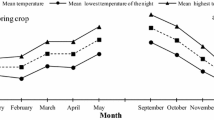Summary
Methods of rooting cuttings, grafting, injecting fluids and of growing potatoes so that the tubers can be observed during growth are described. The growth regulator, CCC, besides causing vegetative stunting, also caused flower buds to drop and may therefore be unsuitable for use on plants raised for genetical purposes.
Zusammenfassung
Folgende Methoden werden beschrieben:
-
1.
Zur Bewurzelung von Kartoffelstecklingen benützt man einen mit feuchtem Torf und grobem Sand gefüllten Pikierkasten, der unter dem Gewächshaustisch gehalten wird. Um die Bewurzelung zu beschleunigen, verwendet man einen Hormonstaub (Abb. 1).
-
2.
Eine Kammer, die zur Anzucht von gepfropften Pflanzen dient, wird aus einer Polyäthylenhülle hergestellt, die über ein Drahtgestell gestülpt wird. Die so geformte Glocke wird im Gewächshaus über den mit feuchtem Torf gefüllten Pikierkasten gestellt und unter dem Tisch gehalten (Abb. 2).
-
3.
Für die Einbringung von Flüssigkeiten in
Kartoffelpflanzen kann man Glasröhrchen benützen, die am geschnittenen Ende des Stengels mit Modellierton befestigt sind (Abb. 3).
Die Methode zur Einführung von Flüssigkeiten in Kartoffelpflanzen scheint sich auch für die Anwendung von Colchizin zwecks somatischer Chromosomenverdopplung oder für die Injektion physiologisch-aktiver Stoffe (zum Beispiel potentielle knolleninduzierender Extrakte) zu eignen (Abb. 4).
-
4.
Um Knollen während der Entwicklung beobachten zu können, fertigt man aus Schaumplastik einen Deckel an, mit dem man die Töpfe abdichten kann. Dadurch entsteht ein dunkler, feuchter Raum über der Erdoberfläche im Topf (Abb. 5).
Die Anwendung des Wachstumsregulators CCC kann möglicherweise für Experimente im Gewächshaus nützlich sein, aber bei einem Versuch bewirkte er das Abfallen von Blütenknospen.
Résumé
Les techniques suivantes sont décrites:
-
1.
Une méthode d'enracinement de boutures en bacs contenant de la tourbe humide et du sable gros, placés en serre sous la tablette, et l'utilisation d'une poudre hormonale pour hâter l'enracinement (Fig. 1).
-
2.
L'utilisation d'une chambre de greffe consistant en une couverture de polyéthylène sur une charpente en fer qui est placée au-dessus des pots mis dans des bacs contenant de la tourbe humide, placés en serre sous la tablette (Fig. 2).
-
3.
L'injection de liquides dans les pommes de terre en utilisant des tubes de verre montés sur l'extrémité de la tige coupée avec de l'argile à modeler (Fig. 3).
La méthode d'injection paraît convenir pour utiliser la colchicine pour le doublement chromosomique somatique (Fig. 4) ou pour appliquer des matières physiologiquement actives (par ex. des extraits capables d'induire la tubérisation).
-
4.
Une méthode d'observation des tubercules en croissance consistant à réaliser un espace obscur et humide à la surface du sol du pot par un tampon en éponge-plastic (Fig. 5).
Le régulateur de croissance CCC peut être utile dans le cas de développement en serre mais, dans une expérience, il causait la chute des boutons floraux.
Similar content being viewed by others
References
Chapman, H. W. (1958): Tuberization in the potato plant.Physiol. Pl. 11, 215–224.
Engel, K.-H., undA. Raeuber (1960): Ein neues Kulturgefäss zur laufenden Beobachtung unterirdisch wachsender Organe (Kartoffeln).Züchter 30, 206–207.
Gregory, L. E. (1956): Some factors for tuberisation in the potato plant.Am. J. Bot. 43, 281–288.
Hooker, W. J. (1950): A technique for observing tuber enlargement and scab development in potatoes.Phytopathology.40, 390–391.
Houghland, G. V. C. (1950): An improved technique for growing potatoes in solution cultures.Am. Potato J. 27, 257–262.
Howard, H. W. (1949): Potato grafting experiments. I. The effect of grafting scions of Epicure on the short-day speciesS. demissum.J. Genet. 49, 235–244.
Howard, H. W. (1961): The production of hexaploidSolanum × juzepczukii.Euphytica. 10, 95–100.
Howard, H. W. (1963): Potato grafting experiments. II. Some further results with the short-day species,Solanum demissum.J. Genet. 58, 177–185.
Howard, H. W. (1964): Experimental production of buds on the roots of potatoes.Nature, Lond. 203, 1303–1304.
Krug, H. (1963): Growth regulation of potato plants during the winter months with special reference to virus diagnosis. In: The Growth of the Potato. ed. Ivins and Milthorpe, London, 221–227.
Lugt, C., K. B. A. Bodlaender andG. Goodijk (1964): Observations on the induction of second growth in potato tubers.Eur. Potato J. 7, 219–227.
Madec, P. (1963): Tuber forming substances in the potato. In: The Growth of the Potato. ed. Ivins and Milthorpe, London, 121–130.
Madec, P., andP. Perennec (1962): Les relations entre l'induction de la tubérization et la croissance chez la plante de pomme de terre (Solanum tuberosum L.)Ann. Physiol. vég. 4, 5–84.
Mes, M. G., andI. Menge (1954): Potato shoot growth and tuber formationin vitro.Physiol. Pl. 7, 637–649.
Schick, R., andM. Klinkowski (eds.) (1961–62): Die Kartoffel, ein Handbuch. 2 vols, Berlin.
Simmonds, N. W. (1965): Observations on tuber induction in potatoes.Eur. Potato J. 8, 92–97.
Author information
Authors and Affiliations
Rights and permissions
About this article
Cite this article
Simmonds, N.W. Some experimental techniques with potatoes. Europ. Potato J. 8, 125–132 (1965). https://doi.org/10.1007/BF02390582
Accepted:
Issue Date:
DOI: https://doi.org/10.1007/BF02390582




